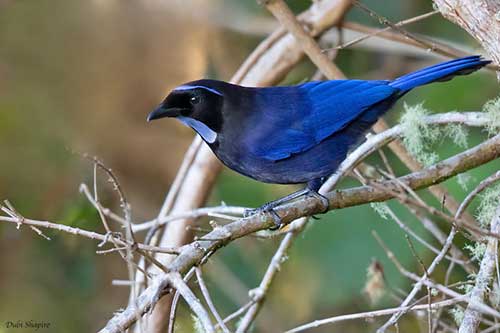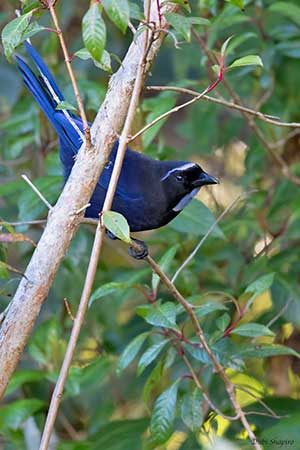
The breeding behaviour of the Silvery-throated Jay is very poorly known. The Corvidae are usually monogamous with strong pair-bong sustained during the year, and frequently for the life.
The Neotropical jays are known to perform co-operative breeding, but more information is required. The restricted habitats and the low population densities do not allow easy observation of their breeding biology.
The Silvery-throated Jay is resident with probably only local and seasonal movements.
The flight is laboured with frequent wingbeats.
REPRODUCTION OF THIS SPECIES:
The breeding season in Costa Rica takes place from March to June.
An observation in April 2016 in Chirripó National Park (Costa Rica) provides a nest description and information about the breeding biology of the Silvery-throated Jay.
A nest was discovered about 8 metres above the ground, high in the middle of the crown of a small tree of less than 10 metres tall. The large cup-shaped nest was made with twigs and vegetal fibres, and the cup contained some moss. The nest-site was on a steep slope, fairly close to a trail used by hikers and horses, and surrounded by dense mature montane cloud forest. The jays were tolerant for human activities on the busy trail.
The egg-laying must have taken place between 18 and 22 April (20 April). The chicks hatched between 12 and 14 May, involving an incubation of about 20-24 days (22 days).
The chicks were naked at hatching. On 3 June, they were stretching their wings and moving continuously in the nest. They were absent on 7 June, indicating a nestling period of more or less 25 days. Three chicks have been observed.
Concerning the adult behaviour, three or more adults were seen around the nest, and three different adults were seen feeding the chicks at the same time.
Three to five adults were observed during the different visits to the nest. During both incubation and nestling period, an adult frequently fed the adult on the nest.
From these observations, the Silvery-throated Jay seems to be a co-operative breeder. It is social and is often seen foraging and roosting in groups. In addition, many jay species are co-operative breeders.
But more observations of the breeding behaviour of jays of genus Cyanolyca are needed, because several habits are currently still unknown.
PROTECTION / THREATS / STATUS:
The Silvery-throated Jay is described as uncommon to rare and local resident in highlands, and the species has fairly restricted range.
The population size is unknown but it is suspected to be stable in the absence of declines or substantial threats.
The Silvery-throated Jay is not globally threatened and currently evaluated as Least Concern.
Fr: Geai à gorge argentée
Ang: Silvery-throated Jay
All: Silberhäher
Esp: Chara Gorjiplateada
Esp (Panama): Urraca Gorguiplateada
Esp (Costa Rica): Urraca gorgiplateada
Ita: Ghiandaia golargento
Nd: Zilverkeelgaai
Sd: diademskrika
Photographer:
Dubi Shapiro
Dubi Shapiro Photo Galleries & Dubi Shapiro Bird's images
Text by Nicole Bouglouan
Sources:
HANDBOOK OF THE BIRDS OF THE WORLD Vol 14 by Josep del Hoyo-Andrew Elliot-David Christie - Lynx Edicions – ISBN: 9788496553507
CROWS AND JAYS by Steve Madge – Ed. Christopher Helm – ISBN: 0713652071
Birds Of Central America: BELIZE, GUATEMALA, HONDURAS, EL SALVADOR, NICARAGUA - De Andrew C. Vallely, Dale Dyer – Editeur: Princeton University Press, 2018 – ISBN: 0691138028, 9780691138022 - 584 pages
L’ENCYCLOPEDIE MONDIALE DES OISEAUX - Dr Christopher M. Perrins - BORDAS - ISBN: 2040185607
ResearchGate - Apparent cooperative breeding at a nest of the Silvery-throated Jay (Cyanolyca argentigula) and first nest description
Author(s): Graham A. Montgomery, Frank Spooner, and Benjamin G. Freeman
Source: The Wilson Journal of Ornithology, 130(2):543-547.
Published By: The Wilson Ornithological Society
Wikipedia, the free encyclopaedia
Silvery-throated Jay
Cyanolyca argentigula
Passeriformes Order – Corvidae Family
INTRODUCTION:
The members of genus Cyanolyca are small, sleek jays. They have dark blue plumage and black mask. The Silvery-throated Jay has conspicuous silvery throat patch and pale stripe across the forecrown.
Two subspecies share the range in Costa Rica and Panama. They live in montane humid cloud forest, mainly with oaks, and occur at high elevations from 2,000 to 3,200 metres, and as low as 1,300 metres, depending on the season.
This species feeds in small groups, taking various invertebrates, frogs, lizards, and also berries and small fruits according to the season.
The breeding behaviour is poorly known but thanks to some observations in Costa Rica, information about nest, clutch and breeding habits are now available.
The Silvery-throated Jay is not globally threatened despite its small range. It is usually described as “uncommon to rare”.
DESCRIPTION OF THE BIRD:
Biometrics:
Length: 25-27 cm
Weight: 65 g
The Silvery-throated Jay of nominate race has dark purplish-blue plumage becoming blackish on head, neck and breast.
On the upperparts, lower back, scapulars, rump and uppertail-coverts are dark purplish-blue. Wings and tail are duller blue. The tail is fairly long and graduated at tip.
On the underparts, the chin is black. Throat and upper breast are silvery-white to pale lavender, contrasting strongly with the black neck and the head sides, and a black breast band on lower breast. This band melts into the dusky purplish-blue of the lower underparts. Underwing and tail underside are blackish.

On the black head, a pale silvery-white to greyish lavender stripe crosses the forecrown and extends backwards in a narrow stripe to above the rear end of the ear-coverts. This pale stripe is similar in colour to the throat patch.
The bill is black. The eyes are dark red. Legs and feet are black to blue-black.
Male and female are similar.
The juvenile resembles adult but the crown is dusky purplish-blue (not black) and the pale head stripe is absent or indistinct.
SUBSPECIES AND RANGE:
The Silvery-throated Jay has two subspecies.
C. argentigula albior is found in Cordillera Central in C Costa Rica.
This race resembles nominate but both throat patch and narrow head stripe are glossy white.
C. argentigula argentigula (described above) is found in Cordillera de Talamanca in S Costa Rica, and in W Chiriquí in W Panama.
HABITAT:
The Silvery-throated Jay frequents the subcanopy of tall, humid oak forests, montane evergreen forests and forest borders. It can be found from 2,000 to 3,200 metres of elevation, but it may occasionally descend down to 1,300 metres to mid-story in openings or at forest edges, probably according to the season.
CALLS AND SONGS: SOUNDS BY XENO-CANTO
The Silvery-throated Jay’s call is a harsh, nasal, slightly scratchy “jew-jeah-jeah” or “jeeh-jeeh-jeeh”. We can also hear a single “nyaaaah” and a harsher “zhraaak”, and a short series of 2-4 sharper “nyat nyat nyat” given when taking flight.
BEHAVIOUR IN THE WILD:
The Silvery-throated Jay feeds on insects and other various invertebrates, small frogs and small lizards, and salamanders. It also consumes berries of Macleania ((Ericaceae) and Miconia (Melastomataceae), and small fruits depending on the season.
It forages in small groups of 4-10 individuals, but outside breeding season, the groups may gather up to 30 birds.
The bird moves methodically through the crowns of trees, searching for prey in wood crevices and probing into epiphytes, mosses, lichens and Bromeliads.
They forage over extensive areas in montane forest. They move through the foliage and forage in canopy or subcanopy. However, they also descend in clearings and at forest edges.
